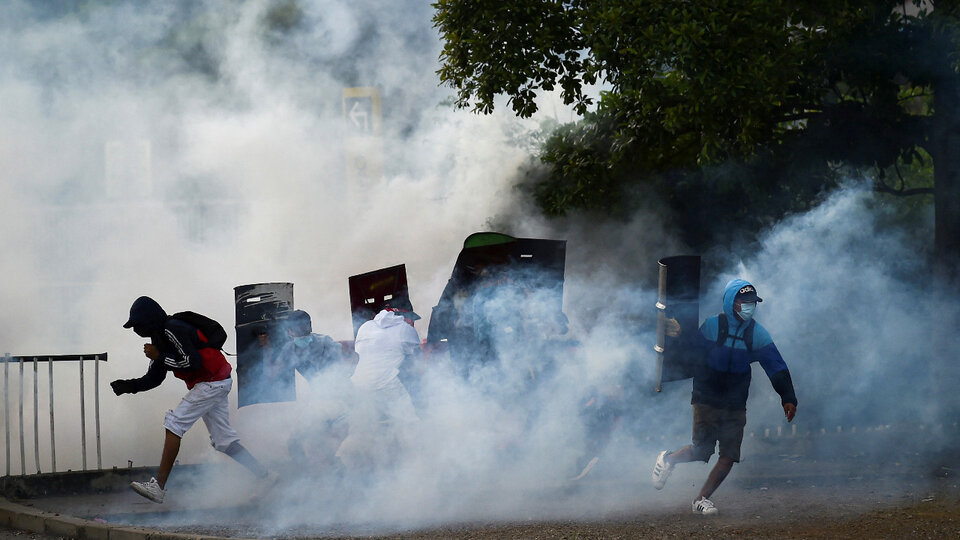
[ad_1]
More organizations denounced the disappearances, torture and the existence of mass graves in the context of anti-government protests in Colombia, while the prosecution reported that 290 people were found “not located” and noted that they were still looking for 129 more. However, other research indicates that the number of people not yet located could exceed 470.
The 21 N legal and humanitarian team, the Justice and Dignity Corporation and the Inter-Church Commission for Justice and Peace (CIJP), published a report on Monday in which reveal reports of sites used by paramilitaries and police for detention, torture and even disappearances of demonstrators in Cali, one of the most repressed cities since the protests erupted on April 28.
Human rights organizations claim that since May 2, when Iván Duque’s government ordered the militarization of cities most active in the protests, there have been complaints that Cali’s municipal administrative center (CAM) is said to be used as a secret operations center by the public forces.
According to the report, “Some young people were taken to basements (of the CAM) and hours later they were taken in polarized vans.“Which, apparently,” are among the means used by the police for their mobility.
In one of these vehicles, “young people were taken at night to the town of Mulaló”, near Cali.
“There, in a previously prepared place they would unload the bodies of young people from working-class neighborhoods who take part in the mobilisations and who consider themselves missing “, alert the text.
Other testimonies indicate that some of the young detainees “ reported missing by their friends or family, they were reportedly “executed” in Guacarí or Buga “, also near Cali.
For her part, last Saturday, Cali’s councilor, Ana Erazo, posted on her Twitter account that she had received videos of bodies found in the Cauca river and underlined: “What we feared is starting to happen”. Erazo asked the mayor of Cali, Jorge Iván Ospina, to form a “commission to verify complaints in Mulaló and possible graves”.
According to a list compiled by the Universidad del Valle, 120 people are missing, while the Working Group on Enforced Disappearances supports the figure of 471.
The Colombian attorney general’s office said 290 people were found who had been flagged as “not located” following the protests, but there were still 129 others in the state.
“These stories provide reasonable evidence of sophisticated criminal plans in which the national police would participate, given their operation from April 28 to today, ”indicates a document from the CIJP.
The United States and the Inter-American Commission on Human Rights (IACHR) also called on the Colombian government to locate the dozens of missing persons as soon as possible, after Bogotá refused entry into the country by officials of organizations. international organizations wishing to verify the humanitarian situation.
Protests began on April 28 against the government’s proposed tax reform, which was quickly withdrawn from Congress.
The response of the State was to repress with the public force, which left more than 50 dead, hundreds injured and at least 21 victims of sexual violenceAccording to figures from the NGO Tremors, although officially, the Ombudsman’s Office kills 42.
In this context, An Argentinian delegation which is part of the International Mission of Solidarity and Observation of Human Rights went to Bogotá this Tuesday morning, with the aim of “accrediting, highlighting and making visible the situation. That Colombia is going through. “On the same territory”, it is therefore proposed to travel through the country affected since the end of April by a mobilization in the streets and complaints for repression of demonstrations and police abuses.
The idea of the Argentine delegation is to stay in Colombia until June 2, and to visit, in addition to Bogotá, other cities of a significant scale in terms of mobilizations, but also those that accumulate the most complaints. for abuse of the security forces.
.
[ad_2]
Source link
 Naaju Breaking News, Live Updates, Latest Headlines, Viral News, Top Stories, Trending Topics, Videos
Naaju Breaking News, Live Updates, Latest Headlines, Viral News, Top Stories, Trending Topics, Videos